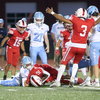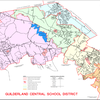As town prepares to phase out digital signs, one remains a sticky wicket
GUILDERLAND — As the town finally appears positioned to end its 18-month affair with ad hoc moratorium extensions on digital-sign applications, Guilderland’s zoning board continues to wrestle with what’s likely to be among the last of the approved programmable placards in town.
Following about four minutes of discussion at the April town meeting, board members were unanimous that programmable digital signs should be prohibited in Guilderland. It was also made clear the decision wasn’t made in mere minutes on April 5; it had taken a lot of earlier work to arrive at the decision.
An amendment to the current law is required, as is input from the town’s planning board. The proposal will come back to the town board for a once-over and then out to a public hearing.
In February, the town was made aware of what some residents had thought was a violation of a local shopping center’s sign permit. But Jacqueline Coons, Guilderland’s chief building and zoning inspector, made the determination that no enforcement action was needed.
Residents had felt the Town Center Plaza at 1704 Western Ave. was not following the conditions of approval laid out in its permit for an electronic digital sign.
Coons, in a Feb. 14 email to the town board explaining her decision not to take any enforcement action, wrote, “The intent of the approval of the digital message board for use as a tenant directory sign at 1700/1704/1710 Western Avenue was to reflect the tenants of the Town Center Plaza and 1700 Multi-Residence projects. If the display is representing that a space is available at this location, that would be consistent with the use of the sign for directory purposes.”
On March 15, resident Iris Broyde asked the town board what more could be done because the zoning board had been clear in its approval “around how that directory sign was going to be used,” but the photos she submitted showed the applicant “pretty clearly to be in violation.”
There were apartments being advertised that should not be advertised, Broyde asserted, as well as classified ads being shown on a sign whose purpose is a tenant directory. The sign is on 24 hours a day, seven days a week, also a violation, she said. Broyde said the typical channels were used “to exact some … ramifications” meaning Coons, but she “declined to take action.”
What brought Broyde to the town board last month was that she was looking for someone to explain to her who in town has the “kind of authority to supersede” the inaction of “what looks like a very should-be-a-very-enforceable action.”
What Broyde ended up doing was, rather than seek a clarification of the town’s zoning map or one of its ordinances, a typical request made on an application to the zoning board, she asked for an interpretation of Town Center’s sign permit.
April’s meeting
“First of all, the application request for the electronic sign at Town Center, expressly proposed to be a directory sign for the stores at 1704 and 1710, the stores at Town Center,” Broyde said during the zoning board’s April meeting. “It says that right on the application.”
The March 2020 sign permit approved by the board confirmed as much, Broyde argued. (The moratorium on programmable digital signs was adopted by the town board in October 2020; it runs until May 24.) The apartments at 1700 Western Ave. didn’t appear on the application for the directory sign, Broyde said.
Broyde noted Chairman Thomas Remmert had been in the minority on the March 2020 vote, 3 to 2, and that she remembered his comments from the meeting: That electronic signs can become a vehicle that can convey any messaging.
Remmert acknowledged the vote and said he was generally opposed to electronic signs, “for several reasons.”
Remmert then read from the state handbook on municipal signs to drive home his point, “The first step in considering the constitutionality of legislation affecting protected speech is to determine whether it is content-neutral or content-based.
“A sign regulation may not define the content of a sign. Sign regulations that are aimed at the content of speech or expression in a public forum are subject to ‘strict scrutiny’ by the Courts.”
The board is restricted from regulating the content of the sign, Remmert said.
And, if the board tried to enforce the conditions in Town Center’s sign permit approval (which mentions the sign’s content), Remmert said he didn’t think it would survive a court challenge.
The three zoning board members — Jacob Crawford, Sharon Cupoli, Elizabeth Lott — who approved Town Center’s sign in March 2020 are still on the board. And on April 6, each acknowledged to a certain extent that the intent and outcome of their 2020 approval aren’t exactly in alignment.
But Lott made the point that “sometimes decisions can be stretched to interpretation.” She said it is Coons’s job to take all of the board’s decisions and, based on her own understanding, interpret and enforce them. “So is it beyond the limits of our decision to say, you can’t have that sign because it’s 1700 [Western Ave.]?”
David Sussman and Linda Griggs of the Wolanin Companies, which owns the four adjacent parcels of land — 1700, 1704, and 1710 Western Ave. — spoke during the April 6 meeting.
Sussman said, when the project was conceived, in the 1990s, Town Center plaza was envisioned as part of a planned development with 1700 Western Ave. apartments. Remmert earlier pointed out that Crossgates Mall is made up of multiple parcels and gets treated like one property.
“The other thing that I would just point out is that there is common ownership,” Sussman said; the properties also operate under a reciprocal easement agreement, so there’s things like shared ingress, egress, and parking among the parcels.
The four properties don’t share the same zoning: 1704 and 1710 Western Ave. are zoned LB, or local business; 1700 Western Ave. is zoned MR, or multi-residential; and the 20.8-acre 6270 Johnston Road Rear, is zoned for a Planned Unit Development.
Griggs told the board, “I just don’t believe they’re saying that we’re trying to push the limits of what we had. Those signs for 1700 [Western Ave.] had been there since we built the place. It wasn’t anything we snuck them in or anything.”
A second opinion
The zoning board concluded it needed its attorney to make a determination on Coons’s determination.
Lott said she wanted to know if 1700 Western Ave. was excluded or if it was just omitted, in which case it could be corrected. “Just because it’s not on the application, is this decision that we make about the sign, does it also apply to 1700?” she asked.
Lott also wanted to know if the town code regulating the size of a sign advertising on-site rentals would apply, because the Town Center Plaza sign exceeds the maximum allowable square footage.
But then Coons offered the board an explanation that had at least one member ready to vote on Broyde’s application request.
When the sign permit was issued for Town Center Plaza in March 2020, Coons had yet to issue one certificate of occupancy to an apartment at the 1700 Designer Residences South, she said.
“It didn’t exist as an entity,” she said.
Coons said 1700 Western Ave. was a remnant of a previous Planned Unit Development proposed under a prior administration whose attention to detail left a lot to be desired.
The earlier plan, first brought to the town’s attention in 2010, Coons said, “honestly, lacked … specifications other than: Here’s a site plan, let them go build it.” The town board, according to Coons, “never changed the local law to reflect what they were actually approving.”
Coons then came back to the slapdash nature of then-Supervisor Ken Runion’s planning at the end of his tenure, pointing to Wolanin’s attempt to have 6270 Johnston Road Rear rezoned to multi-residential, but being told, “We’ll entertain a PUD — so bring us something that incorporates mixed-use into your project.”
The proposal left a lot of i’s undotted and t’s uncrossed, Coons said, and all that’s left for the town’s planning and zoning departments “is a haphazard PUD.”
The town board approved the Planned Unit Development zoning for 1700 Western Ave. in 2015, but the property continues to be designated as multi-residential on the town’s zoning map.
During the March 15 town board meeting, Supervisor Peter Barber had made this point: The 1700 Western property was zoned for a PUD, and its permit also governs the 1704 Western shopping center (currently zoned local business), he said. “It’s the same property for purposes of zoning.”
So, when applicants from 1700 Designer Residences came in, after the March 2020 sign approval, with the first few certificates of occupancy in hand, Coons said on April 6, “It seemed like the sign permit was growing with the project.”
Coons said the zoning board hadn’t seen a sign application because “the applicant hadn’t requested a permanent sign for 1700 South, they were still just trying to represent that they had space for lease.” Coons said the approved site plan for the 1700 Designer Residences shows a commercial building will actually be located on the Town Center Plaza site.
But “then COVID happened,” she said, and “they had just started the buildings — they barely finished the two they had and they weren’t in a position to start any more buildings, nor that commercial building, which is required as part of the PUD.”
If Town Center Plaza were advertising rents for Brandywine-owned apartments (a partner company of Wolanin), Coons said, “I would be the first one to say, ‘I’m sorry, but that’s not part of this property. And that shouldn’t be here, even though you own it.’” But Coons said with the 1700 Designer Residences filling up, it “seemed like a reasonable growth of the project.”
In response to Coons’s explanation, Lott said, “So based on what Jackie just said, do we still need a legal opinion, or are we ready to vote?”
With potential First Amendment implications and a challenge to one of the core functions of Coons’s job, the board decided it would be better to have its attorney weigh in on the matter.
Coons told The Enterprise by email on Tuesday the information is still being put together but she expects it to be all in before the board’s next meeting, on May 4.



